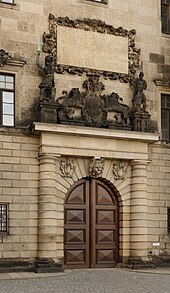Andreas Walther III
Andreas Walther (* 1560 in Dresden , † May 1596 ibid ) was a German sculptor of the Baroque . To distinguish it from other active artists of the same name as Andreas Walther I (sculptor, 1506 to 1568) and Andreas Walther II (sculptor, 1530 to 1583) he is called Andreas Walther III or Andreas Walther III. designated.
Life

He comes from a Silesian-Saxon family of artists . Andreas Walther III was born as the first son of Andreas Walther II in Dresden. He is the older brother of Christoph Walther IV , Michael Walther and Sebastian Walther . He spent his childhood in Dresden, where he worked as a child in his parents' sculptor's workshop at Terrassenstrasse 12. Andreas Walther III is also known as the "Master of Dresden Mannerism ".
In his youth he worked for his ailing father in the execution of sculptural works and at the age of 25, for example, completed the epitaph for Heinrich Pack in the Delitzsch town church of St. Peter and Paul . His early baroque works were expressive and extremely detailed. The architects also gave the sculptors more format, space and design variety. He carried out the sculptural work on his buildings for the master builder and chief engineer Paul Buchner , who worked in Dresden from 1558 . Among other things, the Lusthaus (expansion and design of the upper floor) on the Brühl Terrace , the Stallhof , the Pirnaische Tor and the Brick Gate in Dresden as well as the Königstein Fortress are mentioned .
He died in Dresden in May 1596 and was buried on May 14, 1596 in the Walther family arch in the Frauenkirchhof .
Works (selection
- 1583 to 1585: Completion of the epitaph for Heinrich Pack in the Delitzsch town church.
- 1586: Cast iron stove plate, motif equestrian battle , Beuthen town hall on the Oder .
- 1586: Cast iron stove plate, motif of horse and rider jumping into the fiery abyss , Marcus Curtius, State Museum for Saxon Folk Art Dresden.
- 1586 to 1589: Horse heads, coats of arms and plastic jewelry, courtyard side of the Dresden stable .
- 1587 to 1588: Sculptural decoration on the hunting gate at Dresden Castle , as well as a spa coat of arms held by two lions with warrior figures on the side above the gate.
- 1589 to 1590: Allegorical sculptures at the gate to the small castle courtyard in Dresden.
- 1591 ?: Plastic jewelry on the entrance portal of the Königstein Fortress.
- 1593: Two German imperial statues for the pleasure house on Brühl's terrace , destroyed by explosion in 1747.
- 1591: Ornate sandstone column with the statue of Justitia without a blindfold on the old town hall in Görlitz .
- 1593: a life-size equestrian statue of the Saxon Elector Christian I at the Pirnaischer Tor, destroyed in 1760 by bombardment of Dresden during the Seven Years War .
- 1594: Diana fountain for the pleasure garden in Dresden based on a design by Giovanni Maria Nosseni .
literature
- City Lexicon Dresden. Verlag der Kunst, Dresden and Basel 1994, ISBN 3-364-00300-9 .
- Ernst Sigismund : Walther, Andreas III . In: Hans Vollmer (Hrsg.): General lexicon of fine artists from antiquity to the present . Founded by Ulrich Thieme and Felix Becker . tape 35 : Libra-Wilhelmson . EA Seemann, Leipzig 1942, p. 111 .
- Walter Hentschel : Dresden sculptor of the 16th and 17th centuries. Verlag Hermann Böhlaus Successor, Weimar 1966, pp. 59, 62–65, 68, 104, 105, 135, 136.
- Handbook of German Art Monuments - Dresden. Deutscher Kunstverlag, Munich / Berlin 2005, ISBN 3-422-03110-3 , pp. 41, 46, 48.
- Dehio Handbook of Art Monuments in Poland. Silesia . Deutscher Kunstverlag, Munich / Berlin 2005, ISBN 3-422-03109-X .
- Fritz Löffler : The old Dresden. History of his buildings. Verlag EA Seemann, Leipzig 2006, ISBN 3-86502-000-3 , pp. 479, 493.
- Daniel Jacob: Sculpture Guide Dresden: From Aphrodite to Twin Fountains. Self-published, Freital 2010, ISBN 978-3-942098-05-2 , p. 81.
Web links
Individual evidence
| personal data | |
|---|---|
| SURNAME | Walther, Andreas III |
| ALTERNATIVE NAMES | Walther, Andreas |
| BRIEF DESCRIPTION | German baroque sculptor |
| DATE OF BIRTH | around 1560 |
| PLACE OF BIRTH | Dresden |
| DATE OF DEATH | May 1596 |
| Place of death | Dresden |

